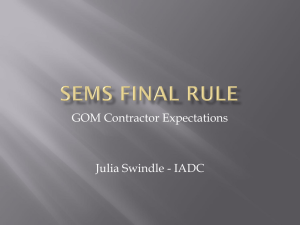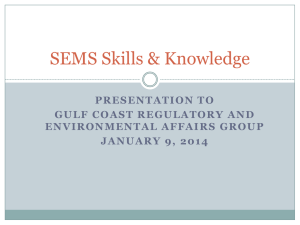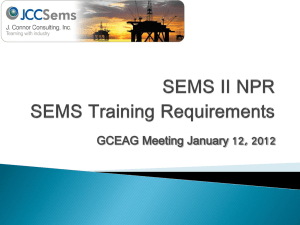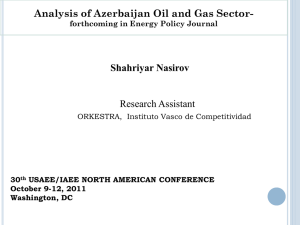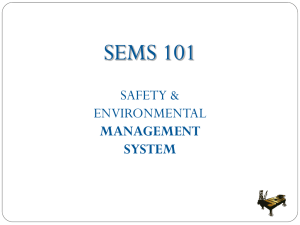SEMS Presentation SCIA
advertisement
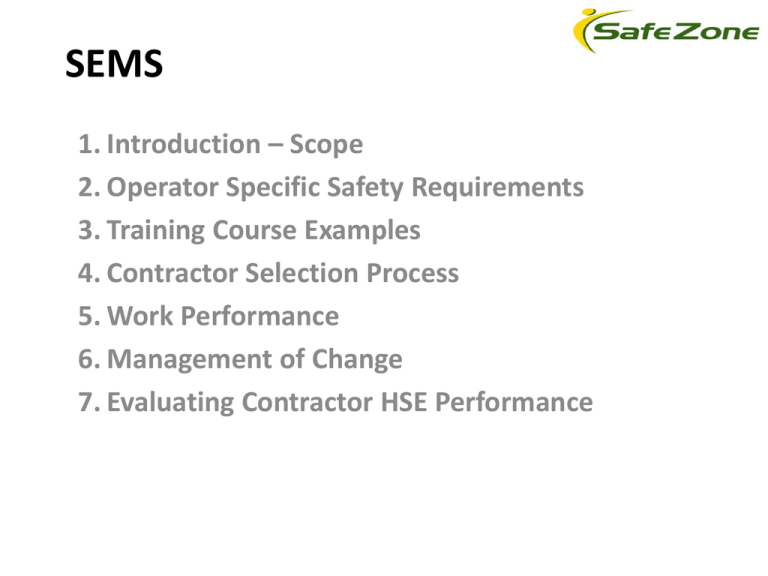
SEMS 1. Introduction – Scope 2. Operator Specific Safety Requirements 3. Training Course Examples 4. Contractor Selection Process 5. Work Performance 6. Management of Change 7. Evaluating Contractor HSE Performance SEMS - Introduction SEMS (Safety Environmental Management System) is derived from an Industry Standard and Practice (API RP 75) and implemented as regulation in 30 CFR 250 Subpart S. Many oil and gas exploration and production companies contract for equipment and personnel services for a wide range of activities, including drilling, production, well servicing, equipment repair, maintenance, and construction. Certain activities of contractors have the potential to place either the contractor and/or the operator personnel or equipment at risk. As a result, it is important that operations are carried out in a safe manner. SEMS - Introduction Commitment Both operator and contractor management commitments are essential in minimizing accidents/incidents and preventing injury and illness. Management commitment begins with the operator and contractor providing the resources necessary for implementing and maintaining an effective safety program. Operator and contractor commitments and continued support is common to all successful safety programs. Effective programs will require the operator and contractor to: • Focus resources on safety, and • Review how contractor safety is being addressed SEMS - Introduction Benefits Operators and contractors benefit when they work together to enhance the management of related safety programs. These benefits may include: • Safety expectations and capabilities are clearly understood before the work begins • Improved safety performance • Better working relationships • Improved safety training for everyone • Improved productivity, reliability and efficiency SEMS - Introduction Third Parties, Subcontractors, and Vendors Frequently, third party, subcontractors and vendors are utilized to perform specialized portions of work projects. In addition, parts and equipment may be used. As a result, they are subject to applicable elements of the operator SEMS Plan or contractor SEMS Policy. Most SEMS Plans or Policies outline provisions for inspections and audits of the relevant third party, subcontractor or vendor services and equipment. SEMS - Introduction The Elements within SEMS 1. 2. 3. 4. 5. 6. 7. 8. 9. 10. 11. 12. 13. General Provisions Safety and Environmental Information Hazards Analysis Management of Change Operating Procedures Safe Work Practices Training Mechanical Integrity Pre Startup Review Emergency Response and Control Investigation of Incidents Audit of Safety and Environmental Systems Records and Documentation SEMS - Introduction In addition, an update has been proposed to include the following (SEMS II) • • • • • • A Stop Work provision Definition of authority Employee participation Reporting unsafe conditions The use of independent third party auditors Additional requirements for Job Safety Analysis It is anticipated that the new rule will come into effect in the fourth quarter of 2012. SEMS – Operator Safety Requirements After determining the type of work to be performed by a contractor, the operator should identify the safety requirements and communicate them to the contractor. These requirements may be broad, or general in certain cases, or very specific in others, depending on the work assignment. Certain contractors (such as those specializing in leak repair or working with radioactive sources) may have more experience and knowledge relevant to the hazards involved and should be consulted in order to establish mutually agreeable and relevant safety procedures. Contractors should consider developing their own safety procedures or programs. In many cases, contractors are used because of their expertise, knowledge of anticipated hazards, and special safety requirements associated with the work. In these instances, a determination must be made as to which individual or company will have primary responsibility for implementing additional safety requirements applicable to their specialty. These must be consistent with operational and regulatory requirements (SEMS). SEMS – Operator Safety Requirements Training Contractors have the responsibility to provide appropriate information and training to ensure that their employees have adequate knowledge and skills to perform their job safely. The contractor is generally responsible for providing safety and job-specific training for its employees unless otherwise stated in a contract or other agreement. Upon final review of the scope of work, operators and contractors may identify any site or job-specific training that is necessary to perform the work safely and agree on how this will be accomplished. Additionally, other considerations include, but may not be limited to: • Short Service Employee Programs • Sample Training Matrix SEMS – Operator Safety Requirements Training Course Examples (as cited in API RP 76) SafeGulf Ergonomics Housekeeping Access to Medical Records Excavation Safety Incident Prevention Bloodborne Pathogens Fall Protection Incident Reporting Confined Space Fire Prevention/Fire Fighting JSA Training Drug & Alcohol Awareness First Aid/CPR Lock Out/Tag Out Electrical Safety Hand Tools Material Handling Emergency Action Plan Hazard Communication New Employee Orientation Environmental Awareness Hearing Conservation Water Survival SEMS – Operator Safety Requirements Verification of Training It is important for the contractor to maintain records of training and make them available to the operator upon request. The contractor should consider periodically reviewing training schedules and materials to verify that they are current. The contractor should maintain training documentation in a way that is easily retrievable. Additionally, contractor personnel may need to carry certain training credentials as required by regulation or the operator. SEMS – Operator Safety Requirements Communication Operators and contractors are responsible for communicating the appropriate information regarding workplace hazards and safety requirements to their employees. The communication of this information may include many formats such as an orientation program, job safety analyses (JSA), safety meetings, pre-job meetings, training, Material Safety Data Sheets (MSDS), safe work permits, signs, posters, procedures, or other written materials. SEMS – Operator Safety Requirements JSA and Safety Meetings Operators and contractors may consider conducting Job Safety Analyses (JSA), safety observations, and regularly scheduled safety meetings to provide on-going training and communication of safety issues. Additionally, a safety awareness or behavior based program may be beneficial. Subcontractors and other third party are usually required to attend all applicable safety meetings. Personnel New to Work Site All personnel new to the work site will be made aware of the job and specific site safety requirements, including emergency training, as applicable SEMS – Contractor Selection Process A major step in achieving acceptable contractor safety performance is selecting a qualified and responsible contractor. Therefore, it is necessary for operators to request that contractors submit safety and training information in their contract response proposals. Such information might include: • • • • • • • • A review of the contractor’s written safety and environmental polices and practices endorsed by the contractor’s top level management A statement of commitment by the contractor to comply with all applicable health, safety, and environmental regulations and provisions of SEMS. Injury and illness experience for the previous three years Outline of the initial employee safety orientation Descriptions of various safety programs including substance abuse prevention and testing Training programs including refresher Short Service Employee programs Completion of the standard safety questionnaire SEMS – Operator Safety Requirements Bid Package (Bridging Document) An operator should inform a contractor of its safety expectations by clearly outlining its safety performance requirements in one or more ways. Several methods used are Request for Proposals, Master Service Agreements (MSA), or Bid Packages. In addition to these methods, SEMS requires a bridging document that may be separate. Safety Questionnaire Operators and contractors may use a Standard Safety Questionnaire or a portion of it to determine whether a contractor’s safety qualifications are adequate for performing the involved scope of work. Major sections of the safety questionnaire may include: • • • • • • General Information Organization Safety Performance Safety Programs and Procedures Training Safety Coordination SEMS – Work Performance It’s important for the operator and contractor to understand their individual responsibilities during the planning, performance, and completion stages of work. As part of the process, the operator may notify the contractor where safety requirements are not being met, but it is usually the responsibility of the contractor, not the operator, to communicate to contractor employees the steps that should be taken to correct any deficiencies. Before work is commenced, the operator should identify and present to the contractor relevant safety rules required. All or part of this information may be used in the safety orientation and safety meetings by the operator or contractor. SEMS – Management of Change Managing change is critical to preventing incidents and controlling loss. The operator and contractor should have a management of change (MOC) process that establishes procedures to identify and control hazards associated with change. The procedures should maintain the consistency of safety processes related to the change. On occasion, temporary repairs, connections, bypasses, or other modifications may be made for operational necessity. (Work Around or Business Continuity) Any of these changes can introduce new hazards or compromise the safeguards built into the original design. Care must be taken to understand the cause and effect of operational, personnel safety and environmental implications of any changes. Although some changes may be minor with the small chance of compromising safety or environmental protection, many changes may have the potential for disruption, injury, or business loss. SEMS – Management of Change Change in Facilities Change at drilling, well servicing and production sites arise whenever the operations or mechanical design is substantively altered. Change may also occur as a result of changes in produced fluids, well servicing fluids, drilling fluids, by-products or waste products, design inventories, instrumentation and control systems, or materials of construction. In many instances, these changes are deemed minor and do not require specific procedures. Typical instances where change would likely occur include: • Construction of new production or process facilities • New facility projects that involve production or process tie-ins to existing facilities, equipment reconfiguration, or modification of existing facilities or equipment • Modification of existing facilities that result in changes to facility or equipment design, structural support, layout or configuration SEMS – Management of Change Change in Facilities Typical instances where change would likely occur – continued: • Projects to increase facility throughput or accommodate different produced fluids • Significant changes in operating conditions, including pressures, temperatures, flow rates, or process conditions different from those in the original process or mechanical design • Equipment changes, including the addition of new equipment or modifications of existing equipment. These can include changes in alarms, instrumentation, and control schemes • Modifications of the process or equipment that cause changes in the facility’s pressure relief instruments. • Bypass connections around equipment that is normally in service • Operations outside the scope of current written operating procedures (start-up, normal & emergency shutdown) SEMS – Management of Change Change in Facilities Typical instances where change would likely occur (continued): • Changes made in the mechanical design or in operating procedures that result from the completion of a hazards analysis • Introduction of new or different chemicals, drilling muds or workover completion fluids • Change in facilities may include mechanical changes that would necessarily appear on a instrument diagram, including drilling and construction equipment, temporary connections, or replaced components that are “not in –kind,” such as1. Replacement equipment or machinery that differs in specifications from the original equipment or previously approved modification 2. Temporary piping, connections, pipe repairs, hoses 3. Alternate supply of materials, catalysts, or reactants 4. Temporary electrical equipment or utility connections, other than emergency situations SEMS – Management of Change Change in Facilities Typical instances where change would likely occur (continued): • Change in facilities may include mechanical changes that would necessarily appear on a instrument diagram, including drilling and construction equipment, temporary connections, or replaced components that are “not in –kind,” such as- (continued) 5. Substantial changes to drilling diverter system design 6. Substantial changes to blowout preventers (BOPs) configuration 7. Substantial changes to top drives or other drilling systems SEMS – Management of Change Change in Personnel Change in personnel, including contractor personnel, occurs whenever there is a change in the organization or in personnel that operate the facility. Routine personnel replacements, rotation, and shift changes should be addressed in operating procedures, safe work practices and training, therefore should not require additional management of change action. Organizational changes, particularly those brought about by the acquisition or sale of a facility, may necessitate a thorough review of the HSE management system. Change in Regulations or Industry Recommended Practices Change in regulations or industry recommended practices can occur when legislators, regulators, and industry groups create, adopt, or modify rules governing activities or operations. Routine review of these laws, rules or practices are warranted . When changes occur, an assessment of the impact and implementation may be needed. SEMS – Management of Change Managing the Change Management systems should establish and implement written procedures to manage change. These procedures should be flexible to accommodate both major and minor changes. Minor changes generally do not require specific procedures. Written procedures should cover the following: • The operations and mechanical design basis for the proposed change • Analysis of HSE considerations involved in the proposed change • Necessary revisions of the operating procedures, safe work practices, and training program • Communication of change and consequences to the appropriate personnel • Necessary revisions of HSE practices and procedures • Duration of change, if temporary • Required authorizations to effect the change, if applicable . SEMS – Evaluating Contractor HSE Performance The operator and contractor each have roles in monitoring and evaluating HSE performance. Safety Performance Reporting All injuries, illnesses and property damage incidents associated with the on-site work should be reported to both contractor and operator as soon as possible. Recording should be done in accordance with applicable requirements for occupational injuries and illnesses. The contractor and operator should identify the mechanism and personnel to forward and receive reports as appropriate. Operator Reviews The operator will periodically review the contractor’s HSE programs, polices and procedures, including questionnaire information, and request that they be updated Contractor Inspections/Audits Contractors should conduct periodic internal reviews, consistent with their procedures. Operators may also perform audits to verify conformance. SEMS Safety Environmental Management System References: 30 CFR 250 Subpart S API RP 75 API RP 76 QUESTIONS?
